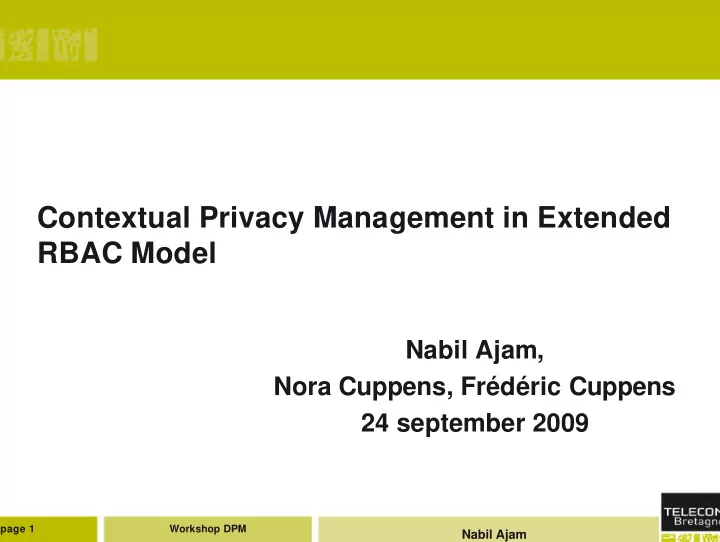

Contextual Privacy Management in Extended RBAC Model Nabil Ajam, Nora Cuppens, Frédéric Cuppens 24 september 2009 page 1 Workshop DPM Nabil Ajam
Plan � Introduction � Motivation to use RBAC models � Privacy requirements as OrBAC contexts � Use case � Conclusion page 2 Workshop DPM Nabil Ajam
Background � Enhanced services extensively use sensitive information � New services threaten user’s privacy • More and more acceptance of such services: community service, location service... � International organisations tend to institute privacy principles • Common acceptance of the OECD requirements (1980) page 3 Workshop DPM Nabil Ajam
Privacy definition � Sensitive data • Any data that can be used to identify directly or indirectly a physical person � Privacy is • The demands from individuals, groups and institutions to determine by themselves when, how and to what extent information about them is to be communicated to others � Data owner • The subject, who the sensitive data is referred to page 4 Workshop DPM Nabil Ajam
Context of work: Three actors for LBS � Operator is the organization that collects, stores and discloses private information about subscribers � Assumption: Subscribers trust the operator organisation � Subscribers can define the privacy policy • Authorized service providers • Different object accuracies • Purpose as user-declared context - A set of access objectives declared by the data owner • Provisional obligation • Consent requirement before delivering data page 5 Workshop DPM Nabil Ajam
Motivation Access Control Model � Location services are able to track subscribers continuously � Idea: Define one model for access control and privacy control page 6 Workshop DPM Nabil Ajam
Plan � Introduction � Motivation to use RBAC models � Privacy requirements as OrBAC contexts � Use case � Conclusion page 7 Workshop DPM Nabil Ajam
Related works � P-RBAC (Purpose-based RBAC) • A dedicated langage to express privacy conditions • Definition of obligations � Purpose-Based Access Control and PuRBAC (Purpose- Aware RBAC) • Intended purposes • Access purposes • Three types of conditions: Constraints, pre-obligations, post- obligations page 8 Workshop DPM Nabil Ajam
Motivation � Common acceptance of RBAC model to express security policy • Reuse existing model • One model for access and privacy control � Extension of RBAC model • Support of dynamic and environment parameters through contexts • Possibility to integrate the majority of privacy requirements • Example: OrBAC model � Integrate privacy for NGN services page 9 Workshop DPM Nabil Ajam
OrBAC model � Two abstraction levels • Concrete: subject, action, object • Abstract: role, activity, view � Policy specification based on the abstract entities: permission, prohibition, obligation, dispensation • Permission(org, role, activity, view, context) � Five context types: • Spatial • Temporal • Provisional • User-declared • Prerequisite page 10 Workshop DPM Nabil Ajam
Plan � Introduction � Motivation to use RBAC models � Privacy requirements as OrBAC contexts � Use case � Conclusion page 11 Workshop DPM Nabil Ajam
Privacy requirements � OECD guidelines (initially concern transborder flow), which are adopted by western countries • Collection limitation (owner consent) • Data quality (need to know) • Purpose specification • Use limitation (owner consent) • Security safeguards • Openess • Individual participation • Accountability page 12 Workshop DPM Nabil Ajam
Privacy requirements : Consent � Data owner can require his consent before delivering his location by the operator � Consent is needed either : • Before data collection • After data collection � User preference is stored within the « consent preference » view by the operator page 13 Workshop DPM Nabil Ajam
Privacy requirements : Consent � Consent object attributes are : • Requestor • Target • Data-owner • NeedConsent � User consent is triggered when page 14 Workshop DPM Nabil Ajam
Privacy requirements: Accuracy � Users can define several accuracies for the same sensitive data � Sensitive data are modelled by an object hierarchy based on the accuracy � Object derivation: compute objects based on the accurate root object � Two accuracy levels • Anonymity level • Cloaked sensitive data (position) - K-anonymity algorithm page 15 Workshop DPM Nabil Ajam
Privacy requirements: Accuracy � Anonymity is considered part of the object accuracy • K-anonymity algorithm � Anonymity level depends on requestors • Each data owner can define several objects page 16 Workshop DPM Nabil Ajam
Privacy requirements: Accuracy page 17 Workshop DPM Nabil Ajam
Privacy requirements : purpose definition � Purpose as user-declared context � Definition of purpose context: • Recipient: who takes advantage of the declared purpose - Service providers • Data owner defines purposes page 18 Workshop DPM Nabil Ajam
Provisional obligation � Enforce usage control after delivering locations � Obligation • Activate condition: when obligation is needed • Violation condition � Obligation is triggered by a provisional context activation page 19 Workshop DPM Nabil Ajam
Plan � Introduction � Motivation to use RBAC models � Privacy requirements as OrBAC contexts � Use case � Conclusion page 20 Workshop DPM Nabil Ajam
Location based service Requestor: service provider User: Data owner Cellular network: Location data Role: fleet_management_1 Purpose: Optimise_route Consent: Yes Accuracy: Anonymous data Obligation: User notification page 21 Workshop DPM Nabil Ajam
Plan � Introduction � Motivation to use RBAC models � Privacy requirements as OrBAC contexts � Use case � Conclusion page 22 Workshop DPM Nabil Ajam
Conclusion � Contribution • Several privacy requirements - Accuracy - Consent - Purpose Modelling privacy requirements • - Consent context - Provisional context - User-declared context � Future works • Model other privacy principles - Remedies, retention, user participation • Policy administration • Privacy policy deployment page 23 Workshop DPM Nabil Ajam
Thanks page 24 Workshop DPM Nabil Ajam
Recommend
More recommend